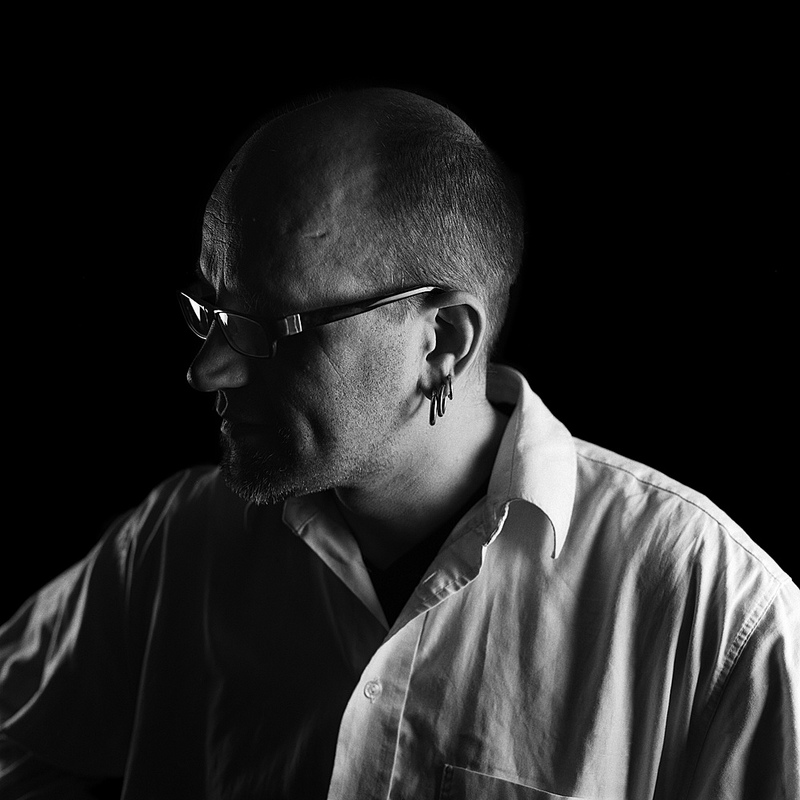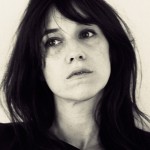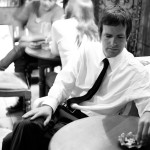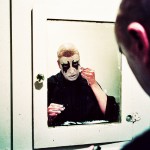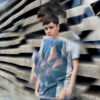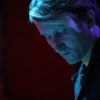[Photos by Jimmy Mould]
Words by Andrew Parks
“I don’t want to do something that’s been done 500 times already,” says Robert Henke (better known as Monolake), “but I guess that’s the fear of every artist. You want to create something of value, and in art production, that value comes from a certain uniqueness. Like there’s a lot of great minimal techno out there; someone else already did it, and they did it a hundred times better than I ever could. So I try to figure out something that’s more my own thing.â€
That’s certainly been the case over the course of the last 15 years, as Henke’s gone from the field recording-fused Berlin techno of Hongkong to the hairpin turns and immersive but chilly club music of Monolake’s last two LPs, Silence and the recently released Ghosts. And then there’s the installations and gallery-invading A/V work Henke’s done under his own name, including a six-channel, deconstructive drone performance of his Layering Buddha album; a “temporal sonic sculpture” inspired by thunderstorms; and his Atom piece “for a matrix of 64 gas balloons, lights and sound.”
As for what he’s up to when we reach him via Skype, Henke’s busy putting the final touches on his Fundamental Forces piece in Vienna. Meant to mimic the what-does-it-all-mean nature of the universe itself, it’s his latest research/performance project with Tarik Barri, an audiovisual composer who’s become Henke’s recurring collaborator in recent years. The pair will present their stunning Ghosts In Surround concert at The Bunker’s Unsound party in Brooklyn on Friday night. Details on that killer bill–Demdike Stare, Laurel Halo, Ital, oh my!–are available here.
And now, onto our lengthy interview, which addresses everything from Henke’s new-found career as a teacher (in the Sound Studies department of the Berlin University of Arts) to the sci-fi book he may or may not publish soon after releasing his next record…
You left your longtime role at Ableton a few years ago to focus on teaching and your own music/art. What are some ways your students have surprised you in terms of how they approach making music?
Well, it’s an art school, and they talk about art in a way that’s very different than how I–a self-taught artist–was thinking about things 20 years ago when I started. They are much more aware of the mechanics of the business, so they know how to approach galleries; they know how to fund raise. In the electronic underground 20 years ago, this was not a topic. So in a way, it’s very refreshing to see how those people approach getting a grant from someone or self-promotion. The way they use media like YouTube is very interesting.
The other side effect of teaching is you get used to talking in front of a class every week, so I can probably do a talk about any topic while sleeping now. It’s auto pilot. [Laughs]
Do you feel like they worry too much about the commerce side of things?
I haven’t come across that. They understand how important it is these days to stand out from the rest and find their own perspective on things. One thing I have noticed is because there’s so many tools out now for making music, people struggle tremendously with the abundance of possibilities. When I started making electronic music, the big question was how do I get something done with my little studio. We were forced to become engineers to get the most basic things done. Nowadays, the kids have everything on their machines and they’re completely overwhelmed by the fact that they have 10 million plug-ins. They don’t know which one to choose. This is a fairly new development.
You don’t feel the same way yourself? I mean, you’re so obsessed with the possibilities of sound and there’s so many different ways a song can go. Do the concepts of your records give them a necessary focus?
I’m still overwhelmed by the possibilities because so many different things can be interesting. The biggest challenge when I start a project is to decide what to ignore. So for instance, right now I’m preparing an installation for a big museum that can go in many directions–I have all of the freedom in the world–but I know that in order to make it good, it needs to be very simple in a way. That’s a hard thing to do. I have a million ideas so I just have to boil it down to the one that’s excellent and execute it. That’s a challenge sometimes–to say, ‘I’m not going to use this; I’m not going to use that.’ Good art is more about reduction than anything else.
How would you describe the Fundamental Forces project you’re working on right now?
It’s 10 screens in a square on all sides with eight-channel sound. The title came after our initial experiments. At some point, we decided it’s all about these forces that tear things apart and bring them together. Once we had the title, we shaped the music and visuals to fit it.
Are you going to package that under your own name later, much like how you have with other art-related releases?
Yeah, Monolake is reserved for more club, beat-oriented things, and everything else is under my name. In this case, it’s a co-production with Robert Henke and Tarik Barri.
Tarik’s become one of your main collaborators in recent years. How does he complement your creative process?
About five years ago, I decided I should stop programming [visuals] and focus on music. So I put something on my site saying, ‘I’m looking for a programmer; please do this test and send the results back.’ I got maybe 10 responses, and I met with four of them. None of them convinced me to work with them, so I felt a little frustrated. Then I got an email back from a guy who said, ‘I saw the announcement on your Web site, but I have absolutely no time because I’m finishing my Master’s degree. I thought I’d give your problem a try, though. I didn’t do much–I just had a half hour–but here’s the result. Maybe you’ll find it useful.’ I looked at the solution he came up with and thought, ‘This guy is brilliant. It’s a shame he’s not available.’
Half a year later, he wrote me again and said, ‘I’m working on a visual engine that’s influenced by a few things you did in the past. You might want to have a look.’ I thought it was great, so I asked him if he wanted to tour with me and do visuals. So I just jumped in the cold water with him; I had a gig the next week in Glasgow, so I paid for his flight there and we tried it out. We met the first time in the elevator at the hotel, and we had our first concert together the same evening. It just worked, so we became collaborators and friends.
When you say he’s a programmer, do you mean he does visuals and music?
He started programming stuff for music, but at some point, he added a visual component out of geekiness and fun. And because he got recognized for his visual work, he stopped doing music.
You said he was really busy when you first met. Are you his main source of work now?
It’s about 2/3 Monolake work; 1/3 his own work. He’s also getting better and better, so we don’t have to spend as much time on my work.
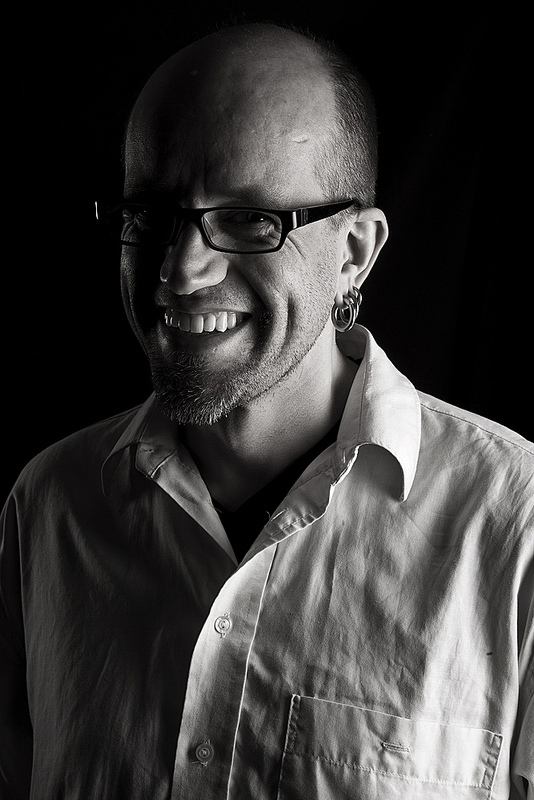 When did you start working on the visual side of Ghosts with him? Was it before the album was even done?
When did you start working on the visual side of Ghosts with him? Was it before the album was even done?
The early Monolake shows [with him] were always a work in progress. We’d just have a jam session together, more or less. With Ghosts, I decided I wanted to do things a little more seriously, so we dedicated some time to work on the show. And after that, it’s been all about refinement. So that’s basically what we did–we spent December and January working on the audio and visual sides of the show. Of course, nothing’s ever truly finished. We changed things at every concert, but the basic structure is finished.
So how would you describe this show in the most non-technical way possible?
It’s an audio-visual concert, and both elements are equally important. We have a big screen and depending on the scenario, we either perform in front of the screen or behind it with some lights behind us. So at some points, they flash and people can see the shadows of us. And after the concert, we come to the front of the stage and show ourselves.
So people can see you were actually doing something:
Well, the interesting thing is how the silhouettes are enough for most people. The visual side is so strong that seeing two people in front of laptops and some boxes isn’t so exciting. Musically, the show is mostly music from the Ghosts album, only played in a different way. There’s a lot of room for improvising, too, if I feel like a piece should be longer or shorter, or if I feel like freaking out over a certain piece. What I will probably add over the next year or so, is more capabilities for improvisation. That way, I’m challenged in a way. If things get too easy, where I know my set completely, I don’t feel the energy anymore.
Your records have been the same way over the years. They’ve never been about a straight 4/4 beat; the imperfections of certain rhythms have kept things exciting.
Yeah, I came from this tradition of Basic Channel where a straight bass drum is such a prominent element of the style. It was really liberating when I decided to try out other rhythms. I can still enjoy a straight bass drum, but there’s so many people doing cool stuff with them, I feel more comfortable working with more broken, deconstructed rhythms.
The details have always been really important with your work. Do you remember when you first fell in love with the possibilities of sound itself?
There’s two or three milestones for me here. When I was really young–maybe 6 or 7–I discovered Jean Michel Jarre at a friend of my parents. If I listen to it now, I find it incredibly cheesy, but back in ’75 or ’76, it was really mind-blowing. Electronic music was like nothing I’d ever experienced before–suddenly there’s this thing with no guitars and no vocals that isn’t pop at all. It had this completely different aura and vibe.
It must have sounded alien to you.
Absolutely. So I was extremely fascinated by that, Aad in a later stage–in the mid ‘80s–I was listening to all kinds of [synth pop]. The moment I realized what I could do by myself was when I moved to Berlin, though. In Berlin, I had two experiences at the same time. One was discovering techno–which was really rough and raw then–and the whole culture around it, of going to a dark place with strobes and people dancing, sweaty, all night. I found this really impressive. For instance, I remember going to see Richie Hawtin play live at Tresor in Berlin. It was just him, two drum machines, an effects box and a mixer–a very simple setup. And he was just going crazy. I loved that energy.
At the same time, I was at a technical university in Berlin, one with a really important studio for academic computer music. So I was exposed to musique concrete and that whole academic computer music world. On one side, I was exposed to this very detailed sound that wasn’t rhythmic at all, and on the other, there was this super raw, endless stream of beats in electronic dance music. So I tried to merge the two. That was it.
The way you approach music may be very technical, but there’s still a lot of life and emotion at the heart of it. Has that been important since the beginning–making sure the process doesn’t overwhelm what you’re trying to express with it?
The one thing I always thought was amazing about music is how a few notes can make you feel something. I’m not interested in music as a theoretical concept. I’m interested in music that grabs me and creates a certain emotion. If I had to choose between the perfect concept and the perfect emotion, I’d choose the perfect emotion.
What are a few seminal records that made you feel something deeper at a young age?
Well, there’s a few things I won’t mention anymore because there’s a certain amount of guilt involved in listening to them. [Laughs]
The idea of guilty pleasures doesn’t seem to be as strong anymore though. Lots of kids are growing up with the same level of respect for mainstream and underground music. So does this mean you really liked Depeche Mode and just won’t admit it now?
Well, actually I’ve no problem admitting I really liked them. The sonic palette of mid-‘80s Depeche Mode is great, like Some Great Reward and A Broken Frame. That’s a good example, actually–A Broken Frame has a very distinct sound and color to it. Every single piece on it is dark, but in a really unique way. It certainly grabbed me.
To a lesser extent, I have to admit I was still really into Pink Floyd in the early ‘80s. I was really amazed by their combination of emotion and masterful production. It may be hard to enjoy these days–this out of time melodrama–but it still sounds so great. It’s such an achievement. If you listen to The Wall as a piece of engineering and sophistication, you think, ‘Man, this is 30 years old and it sounds so good, it’s shocking.’
You’ve lived in Berlin for two decades now. Are there any generalizations you can make about how the music scene has changed during that time?
The scene has become more compartmentalized as a net result of it becoming so big and diverse. In the early ‘90s, if you were into techno, you only had to go to three clubs to meet everyone who’s important, including all of the international artists. You’d go to Tresor to see all of the Detroit people, or you’d go to Panasonic to see the more minimalistic people, and nowadays, there’s tons of clubs and tons of producers. You’ll rarely go to a concert where everyone is. The scene got more divided, which changed the vibe of the whole thing. At the same time, due to things like Facebook, email and Skype, it’s easier to be in touch with like-minded producers from other countries.
So did you hardly know anyone when you first moved to Berlin?
Since the scene was relatively small, it was pretty easy to meet everyone who was important. You just went to a few of the clubs five times, and then you knew all of the faces. I slipped into this whole scene. Like I got in touch with the Basic Channel guys because they were opening a mastering studio.
Were you already familiar with Detroit techno and other electronic music of the ‘80s before you moved to Berlin?
I got really familiar with this culture after I became a frequent guest at the Hard Wax record store. It still plays a significant role as a focus point. The stuff recommended there is definitely still worth listening to.
What do you find yourself listening to these days?
I’ve been listening to a lot of avant-garde music from the 20th century, actually. I’m not the only one, either. Aphex Twin had this fantastic performance where he played a piece by Krzysztof Penderecki, a fantastic 20th century composer. There’s a lot of interest in Philip Glass, Steve Reich:I also listen to some select electronic music when I come across it. In general, though, since I’m not DJing, I’m not a person standing at the record shop every weekend. I don’t really care if a record came out two weeks ago or 20 years ago. I try to be as open as possible. I can find the things I’m interested in in pretty much any genre or time frame. A classic example is Beethoven’s “Symphony No. 5.†It was a complete shock at the time it was made, as it violated all of the rules. In a way, it was as punk as things could be back then. The whole symphony is based on one single motif–‘da, da, da, da!’–and it’s repeated again and again, in different ways. Beethoven was basically using a sample. It’s funny to realize that 200 years later.
Going back to your new record, it’s the second part of a planned trilogy. When did that idea come together?
The idea of the trilogy came in the middle of making Ghosts. I saw some similarities in the process between Ghosts and Silence. As for the text part, I’ve always written stuff out. I just haven’t published it. I like writing. I wrote a very long science fiction story that starts in 1980 and ends in 2030, and there’s a little excerpt from it in Silence, and a longer one on Ghosts. They both belong to this larger story. Another fragment will be in the third part of the trilogy, then I guess the idea is to publish the full story. Then everything will become clear.
What’s the basic premise of the story?
It’s classic science fiction, but it’s not about aliens or anything. It’s more of a thriller in the sense that it’s about a corporation trying to exploit something they find highly valuable. Meanwhile, their competition has other ideas.
So everyone is using everyone, and the science fiction part comes in as the story ends in 2030, when the main protagonist decides that Earth is not the place to be anymore; that he should change his identity and move up there. What he soon finds out is that he’s not the only person who thought of that. So they’re back where they were at the beginning–thrown together again.
And the same problems exist wherever you are.
Exactly.
The next record is called Escape right?
That’s the working title. This year is very full with more art-related work so I probably won’t be able to finish it until next year. A lot of things might change during that time.
Is the record supposed to be reflective of the planet he escaped to?
What I currently have in mind is a very dark, mellow and distant record–not many hi-hats, not many metallic things in the foreground. Just throw rhythms and a big droning machine, with occasional feedbacks from the past. One plan I have is to slow down samples from Silence and Ghosts so that they appear like memories. But I’m just collecting ideas right now. It might turn out completely differently.
This story sounds really involved. Have you worked on it for a while now?
The core of the story is three or four years old, although it’s still not finished yet. The story keeps evolving as I tell people about it, and I find problems with it. It’s like the old ages, when people sat around a campfire and told stories. You improvise until it gets better.
Does the story have a title yet?
No.
Is this something you’ve done privately over the years? And is this the first time you’ve felt comfortable with the idea of publishing your writing?
I never thought of myself as a writer. I mean, I excessively kept a diary when I was younger, and I wrote a few articles about technical things. I also have to write for the university sometimes, so I’ve gotten used to it. I find it fun. Sometimes I’ll write stories for friends–funny things, just a half a page of text when I’m at the airport feeling bored. At some point, I started to take this whole process all more seriously. I’m not sure I will ever publish the whole story. It needs to be good, and if I don’t feel like it’s ready, I won’t publish it. It’d be nice if it turns out to be good, though. [Laughs>]
Is the book as abstract as the excerpts that are in your last two records?
The records are meant to be very open-ended. In a way, the story is similar–there’s these short stories that are quite abstract, but there’s a few people holding it all together. So you’ll notice a lot of the same [characters]. It’s a classical literature thing, really, with a protagonist and antagonist. It’s all written from the perspective of a journalist.
Is the journalist the evil antagonist?
That’s a difficult question. The protagonist. [Laughs] And the other guy–a scientist named Miller, who was already present on Silence–is always crossing his path. That’s the hook of the whole thing.
